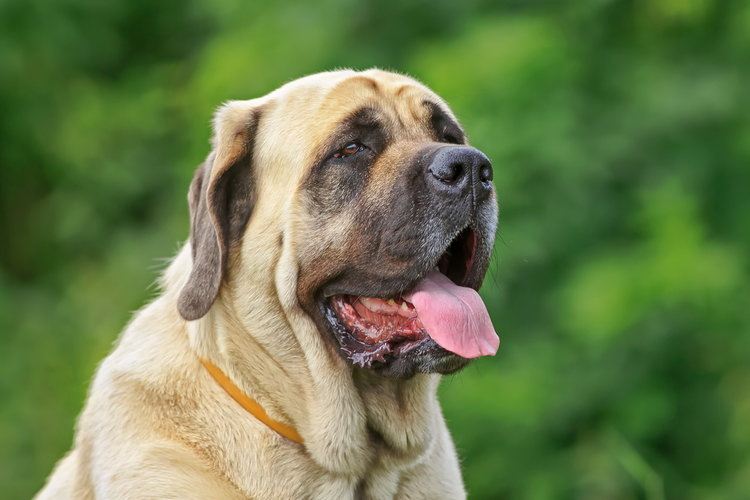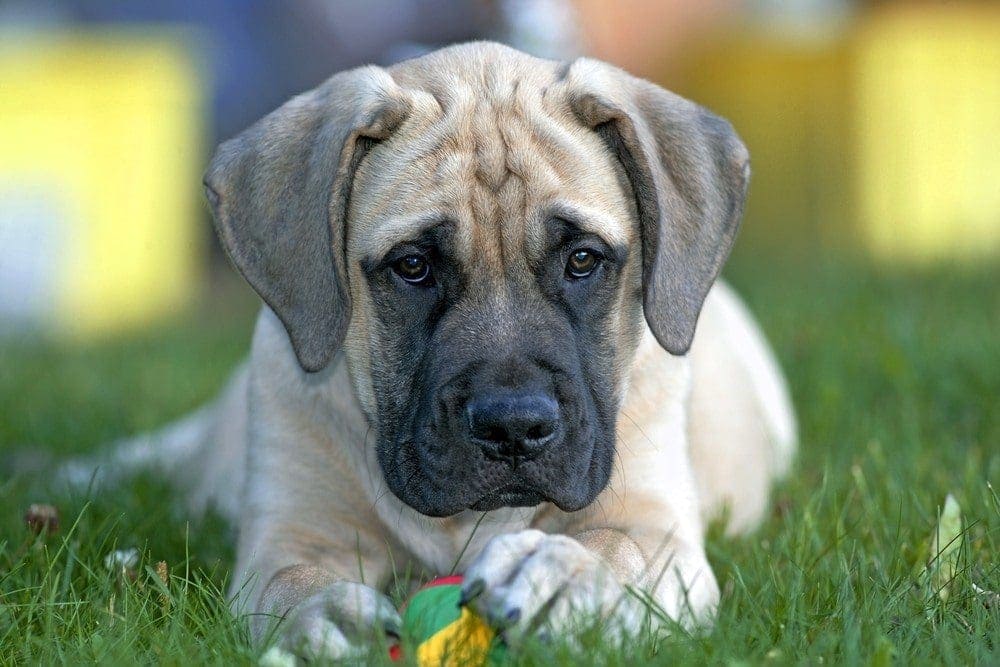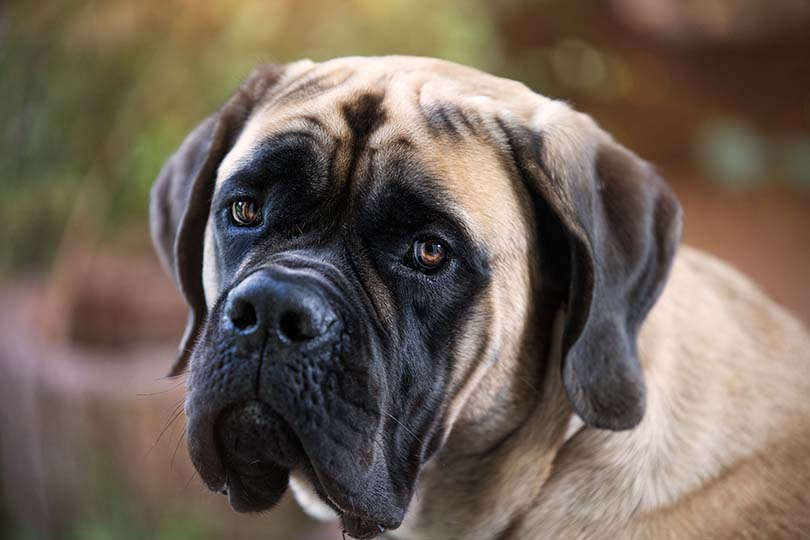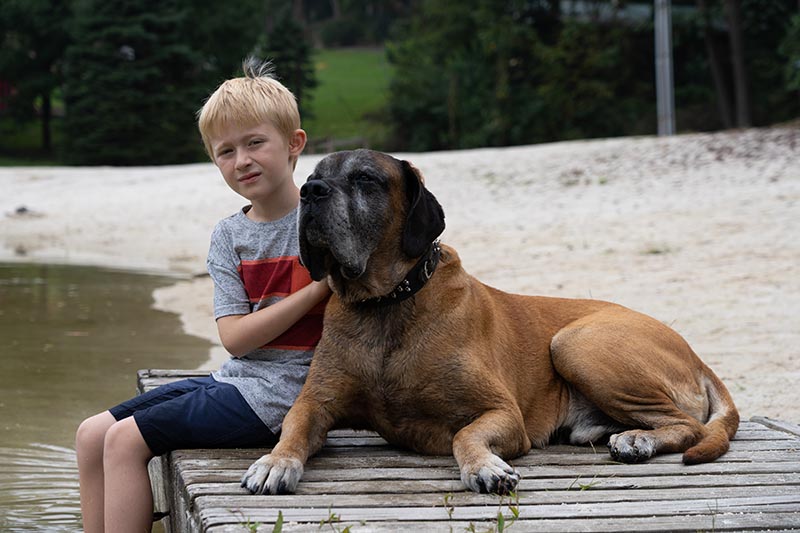
Click Below to Skip Ahead
The huge English Mastiff is sure to turn heads wherever they go, but they’re certainly not as intimidating in character as their looks might suggest. These powerful dogs are the heaviest dog breed! Mature males can weigh 170 pounds, although it’s also possible they’ll grow even larger.
Breed Overview
Height:
18-24 inches
Weight:
120-170 pounds
Lifespan:
6-10 years
Colors:
Fawn, brindle, and apricot, with a black mask
Suitable for:
Experienced dog owners looking for a large and powerful yet laidback breed
Temperament:
Protective yet docile around those they trust, patient and courageous
Despite their massive size, these patient dogs are docile and laidback around their families. They can certainly protect you from strangers, though. Their natural nature is to loyally guard their homes, so you need to be confident that you can train a Mastiff to listen to commands when required.
Also sometimes simply called the Mastiff or Old English Mastiff, this breed is a massive commitment in terms of training, not to mention that food bill! If you’re ready to find out more about this noble breed, you’ll find everything that you need to know right here.
English Mastiff Characteristics
English Mastiff Puppies

It’s true that these puppies are bigger than average, but they’re still adorable. Before you get tempted to reserve a sweet English Mastiff puppy, though, you need to be 100% sure that you and your family can provide what this breed needs to grow into a healthy and well-adjusted adult dog.
Giant breeds like the Mastiff have different needs than smaller dog breeds when it comes to their nutrition and exercise as puppies. Making sure your puppy matures correctly is a serious commitment that takes dedication and time.
While English Mastiffs are gentle and friendly with their families, they are wary of strangers and won’t hesitate to protect their own patch if they think that you’re being threatened. The fact that the threat is actually the mail carrier won’t necessarily put them off! So, early socialization is critical with this breed. It’s vital to be confident that you can control a dog breed that can weigh up to and over 170 pounds when fully grown.
Temperament & Intelligence of the English Mastiff
If you’ve ever had the pleasure of meeting an English Mastiff as a trusted friend, you’ll know them as gentle, patient, and friendly. Their huge size belies a sweet-natured dog that loves to watch over their families. On the other side of the coin, if you meet an English Mastiff as a stranger is approaching their home unannounced, you’ll see why this breed is famed as such a fierce protector. Their massive size and deep bark are extremely intimidating and the reasons they’ve been used as such successful guard dogs!
Owners of English Mastiffs need to be sure that they can train and socialize their dogs to accept strangers of both the human and dog variety. Keeping a Mastiff without taking the time to train them would be dangerous and irresponsible. Male Mastiffs can easily grow to weigh as much, if not more, than the average human, so being able to control your dog using training aids is vital.
English Mastiffs love to please their owners, and while they might be clever, they’re not the most motivated of learners. They might simply ignore you and prefer to do their own thing instead!
Are These Dogs Good for Families? 👪
The gentle and protective nature of the English Mastiff can make them a wonderful family pet, as long as they’re well socialized and trained from a young age. It’s important to train a Mastiff to get along with strangers and other dogs, as well as ask them to respond to verbal commands.
They make laidback and sociable family dogs, but they might not have the energy to indulge in long play sessions. When they’re tired, they will simply flop down and admit defeat! Care needs to be taken around younger and older family members, simply because of this breed’s huge size. While they are chilled out, they can accidentally knock someone over if you’re not careful!
They do love to play and interact with kids, as long as those kids have been taught how to respectfully interact with a large breed and to allow your Mastiff time to rest when the game is over.

Does This Breed Get Along With Other Pets?
The English Mastiff can get along well with other pets, but again, early socialization is vital. They don’t have a high prey drive, so cats and other small pets will probably not even register on their radar. With that said, you should still take the time to introduce them slowly, and don’t leave them together unattended.
If not socialized when young enough the Mastiff’s protective streak can extend to other dogs as well. If a Mastiff decides that they need to defend their patch, then absolutely everyone in the vicinity will know about it. Signing up for puppy training classes and getting your Mastiff used to meeting a wide variety of other dogs is important.
They can happily live in a multi-dog household as long as you’ve done the necessary training. But if your Mastiff has lived alone with little socialization, then you may need professional training support before you introduce another dog to the family.
Things to Know When Owning an English Mastiff
Owning a giant breed like the English Mastiff takes dog ownership to another level. As well as the usual responsibilities, it’s important to prioritize training and the correct nutrition for these massive dogs. Here are a few more details you’ll need to know.
Food & Diet Requirements🦴
While the correct nutrition for any puppy is important, giant breeds have even more delicate needs when it comes to their food requirements. It’s vital not to overfeed your English Mastiff puppy, as their growth rate needs to be slow rather than rapid. Standard puppy feeds are often too high in protein, so an adult formulation with a protein content of around 26% is more suitable.
The ratio of calcium to phosphorous also needs to be carefully controlled to reduce the risk of skeletal problems developing as your puppy matures. They also shouldn’t be allowed to gain weight too fast, so make sure to stick to regular meal times rather than leaving food down for your puppy to eat as they want to.
Your veterinarian will be best placed to help you devise a nutritional plan for your own puppy, as catering to the nutritional needs of an English Mastiff does require more research and a different approach than for many other breeds.

Exercise🐕
As your puppy is maturing, it’s important not to over-exercise them. As tempting as it can be to indulge in long walks and strenuous play, there’s actually nothing worse for a Mastiff pup.
Again, slow and steady is the key here, so puppies of up to six months old shouldn’t be walked more than half a block. They also shouldn’t be allowed to climb stairs too fast or jump from excessive heights.
As they mature, English Mastiffs don’t actually need as much exercise as you might think. A walk of up to 2 miles per day will usually be more than enough for them in the winter, and during the summer, a shorter walk will suit just as well. Mastiffs are well-known for simply sitting down and refusing to move if they’ve decided that they’ve had enough exercise. If this happens halfway through your walk, you’re in trouble! A better method is to stick to shorter walks and spend time hanging out in the backyard or your local dog park instead
Training🎾
English Mastiffs have particular requirements when it comes to training as well! As such a huge breed, correct training and socialization are so important for these dogs. Simply leaving training until they’re a bit older is not an option. Puppy training classes will help get your Mastiff used to meeting a wide range of humans and other dogs, which will help stop them from becoming quite as territorial and protective as they mature. Working with a professional trainer will also help you to refine your training skills and use the methods that suit your dog best.
English Mastiffs can be a little stubborn, so while they are intelligent, if they get bored of repeating the same commands, they’ll simply sit down and switch off. By that point, it will be pretty much impossible to get their attention again.
Mastiffs might be big but they’re exceptionally sensitive. They can pick up subtle signals in your body language and expressions that you might not even be aware of. Raising your voice around them is also a big no-no and will hurt the feelings of your big dog. Positive reinforcement works well with this breed, as do short sessions to keep your dog’s interest.

Grooming✂️
Grooming an English Mastiff is quite straightforward! Their short coat only needs a weekly brush for most of the year. They may shed their coats once or twice a year, so at these times, you’ll need to brush them daily instead.
At the same time as their brushing sessions, check your dog’s nails, teeth, and ears.
English Mastiffs do drool quite a bit! You might find you need to wipe their muzzles regularly, or you can give in and let the drool take over!
Health and Conditions🏥
English Mastiffs are generally a healthy breed, but there are specific health conditions that you need to be aware of. Any reputable breeder will provide more details about all these conditions, but we’ve provided a brief list below.
Male vs. Female
Even though the English Mastiff does need a little more care and attention than some smaller breeds, you might be captivated by the thought of owning one of these gentle giants. Maybe you’re even discussing with a breeder how many male and female pups they have before you put down a reservation.
If at all possible, we highly recommend meeting a litter of puppies before you decide on if you want a male or female pup. You might end up being charmed by a female when you always thought you’d pick a male puppy. Choose your pup for their personality first and their sex second, and you won’t be disappointed!
Males can be heavier than females, but in all honesty, both sexes are heavy, and you’ll need to be sure you can cope with a dog who may end up weighing more than you do!
If you’re concerned about sex-related behaviors, then be assured that these will stop when you have your puppy spayed or neutered at a suitable age.
3 Little-Known Facts About the English Mastiff
1. The English Mastiff nearly became extinct
English Mastiffs were used as war dogs in the Battle of Agincourt in 1415 and both World Wars. After World War II, the British population of English Mastiffs was utterly decimated. It’s thought that only 14 dogs survived, and the breed was on the brink of becoming extinct. Thankfully, breeders in the U.S.A. exported some of these dogs and set about rebuilding the breed. Now, the English Mastiff consistently ranks in the top 30 of the most popular dog breeds in the U.S.A.
2. The largest English Mastiff weighed 345 pounds
Aicama Zorba of La-Susa, a male English Mastiff, held the Guinness World Records title for not just the heaviest dog, but the longest too. Besides weighing 345 pounds, he stood 37 inches tall at the shoulder and measured 8 feet, 3 inches from nose to tail tip. That’s one seriously big dog!

3. The word “Mastiff” has a special meaning
This is an ancient breed, and the word “mastiff” has its root in the Latin word “mansuetus.” This translates to mild, gentle, and tame — accurate descriptions of the English Mastiff when surrounded by their family!
Final Thoughts
Our comprehensive introduction to the massive and mild English Mastiff should have told you everything you need to know about this gorgeous breed. While they’re mild-mannered and affectionate with their families, don’t be fooled into thinking that everyone will be treated to their softer side. A fully grown English Mastiff intent on protecting their family and territory can be a seriously intimidating and impressive sight.
Correct training and socialization from a young age are vital for this breed. Spend the time when they’re puppies, and you won’t regret it. These massive dogs also need plenty of attention paid to their diet and exercise as they mature. Working with your veterinarian to make sure you’re doing everything correctly is a great idea.
As with many giant breeds, the English Mastiff doesn’t have such a long life expectancy as some smaller breeds, but if you decide to bring one of these gentle giants into your home, then you’re guaranteed a kind and gentle addition to your family.
Featured Image Credit: Waldemar Dabrowski, Shutterstock







